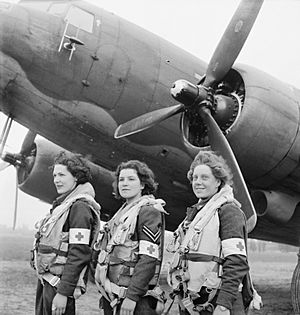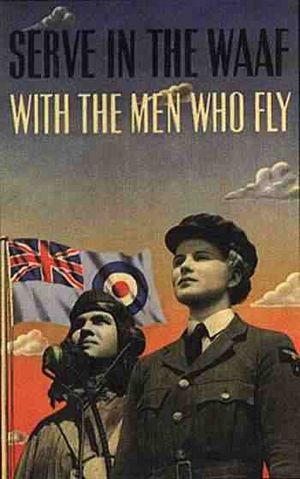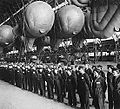Women's Auxiliary Air Force facts for kids
The Women's Auxiliary Air Force (WAAF) was a special group for women who helped the Royal Air Force (RAF) during World War II. Members of this group were often called WAAFs. It started in 1939, and by 1943, over 180,000 women had joined, with more than 2,000 signing up every week! These brave women played a huge part in supporting the RAF during the war.
Contents
How the WAAF Started
The WAAF was created on June 28, 1939. Before this, there was a similar group called the Women's Royal Air Force from 1918 to 1920. The new WAAF took over from 48 companies of the Auxiliary Territorial Service that had been helping the RAF since 1938.
At first, women joined the WAAF voluntarily. Later, in 1941, women between 20 and 30 years old could be asked to join. They had a choice: they could either join the WAAF or work in factories to help the war effort.
Training to Become a WAAF
When women joined the WAAF, they received basic training. This training taught them important skills for their roles. There were five main training locations, but by 1943, all new WAAF recruits trained at a place called Wilmslow.
What WAAFs Did During the War
WAAFs did not fly planes in combat. Women pilots flew for a civilian group called the Air Transport Auxiliary. Even though WAAFs weren't in direct battles, they faced dangers just like anyone working at military bases during wartime.
WAAFs had many important jobs:
- They packed parachutes for airmen.
- They helped manage barrage balloons, which were big balloons used to protect cities from enemy planes.
- They worked in catering, making sure everyone had food.
- They studied the weather as meteorology experts.
- They operated radar systems, which helped spot enemy aircraft.
- They helped with aircraft maintenance, keeping planes in good shape.
- They handled transport, moving supplies and people.
- They managed communications, using wireless, telephone, and telegraph systems.
- They worked with secret codes and ciphers.
- They looked at photographs taken from planes to gather information.
- They also helped with intelligence operations, gathering important facts about the enemy.
WAAFs were especially important in controlling aircraft. They worked in radar stations and as plotters in operation rooms. During the famous Battle of Britain, these plotters helped direct fighter planes against the German air force (Luftwaffe). They mapped where friendly and enemy aircraft were, which was vital for winning the battle.
WAAF Pay and End of Service
WAAFs were paid about two-thirds of what male RAF members earned for similar jobs. After World War II ended, many WAAFs left the service. The remaining few hundred members were renamed the Women's Royal Air Force in 1949.
Leaders of the WAAF
The WAAF had several important leaders, called Directors.
- Dame Jane Trefusis Forbes was the first Director, starting in June 1939. She was a very important leader for the WAAF.
- Princess Alice, Duchess of Gloucester took over as Director in October 1943 while Dame Jane Trefusis Forbes was away.
- Dame Mary Welsh became Director in August 1944.
- Dame Felicity Hanbury was the final Director of the WAAF, serving from December 1946 until the group was renamed in 1949.
Ranks in the WAAF
The WAAF had its own system of ranks, similar to the RAF, but with some differences, especially for officers. At first, they used a system from another women's service, but soon changed to their own. From 1940, women could not join directly as officers; they had to start in other ranks and then be promoted.
WAAFs and Secret Operations
Some WAAF members worked with the Special Operations Executive (SOE) during World War II. The SOE was a secret organization that carried out missions behind enemy lines. These WAAFs were very brave and did dangerous work.
One famous WAAF was Noor Inayat Khan. She was a secret agent who worked in France and showed incredible courage. She was awarded the George Cross, a very high honor, for her bravery. Other WAAFs who served with the SOE included:
- Yvonne Baseden
- Yolande Beekman
- Sonya Butt
- Muriel Byck
- Yvonne Cormeau
- Alix D'Unienville
- Krystyna Skarbek (also known as Christine Granville)
- Mary Katherine Herbert
- Phyllis Latour
- Cecily Lefort
- Patricia O'Sullivan
- Haviva Reik
- Lilian Rolfe
- Diana Rowden
- Anne-Marie Walters
Flying Nightingales
Some WAAF nursing orderlies had a very special and brave job. They flew on RAF transport planes to bring wounded soldiers back from the battlefields, especially after the D-Day landings in Normandy. The press called them "Flying Nightingales" because they were like nurses in the sky.
These WAAFs were trained to care for injured people during flights. They learned how to use oxygen, give injections, and handle different types of injuries like broken bones, burns, and head injuries. They also learned about how flying at high altitudes could affect patients. The planes they flew in, called Dakotas, also carried military supplies, so they couldn't display the Red Cross symbol.
In 2008, the seven surviving "Flying Nightingales" were given special awards for their amazing service.
Ranks
Initially, the WAAF used the ATS ranking system, although the director held the rank of senior controller (equivalent to brigadier in the British Army and air commodore in the RAF) instead of chief controller (equivalent to major-general or air vice-marshal) as in the ATS. However, in December 1939 the title was changed to air commandant, when the ranks were renamed and reorganised. Other ranks now held identical ranks to male RAF personnel, but officers continued to have a separate rank system, although now different from that of the ATS. From February 1940 it was no longer possible to enter directly as an officer; from that time all officers were appointed from the other ranks. From July 1941 WAAF officers held full commissions. On 1 January 1943, the rank of air chief commandant (equivalent to air vice-marshal) was created with the director's appointment to that rank.
Officers
| Air officers | Field officers | Junior officers | ||||||||||||||||||||||||||||||||||
|---|---|---|---|---|---|---|---|---|---|---|---|---|---|---|---|---|---|---|---|---|---|---|---|---|---|---|---|---|---|---|---|---|---|---|---|---|
(1939-1940) |
 |
 |
 |
 |
 |
 |
 |
|||||||||||||||||||||||||||||
| Senior Controller | Controller | Chief Commandant | Senior Commandant | Company Commander | Deputy Company Commander | Company Assistant
|
||||||||||||||||||||||||||||||
(1940-1949) |
 |
 |
 |
 |
 |
 |
 |
 |
||||||||||||||||||||||||||||
| Air Chief Commandant | Air Commandant | Group Officer | Wing Officer | Squadron Officer | Flight Officer | Section Officer | Assistant Section Officer
|
|||||||||||||||||||||||||||||
 |
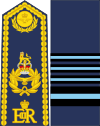 |
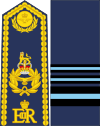 |
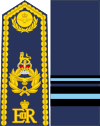 |
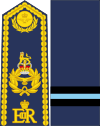 |
 |
 |
 |
 |
 |
 |
 |
|||||||||||||||||||||||||
| Marshal of the RAF | Air chief marshal | Air marshal | Air vice-marshal | Air commodore | Group captain | Wing commander | Squadron leader | Flight lieutenant | Flying officer | Pilot officer /acting pilot officer |
Officer cadet
|
|||||||||||||||||||||||||
| NATO code | OF-10 | OF-9 | OF-8 | OF-7 | OF-6 | OF-5 | OF-4 | OF-3 | OF-2 | OF-1 | OF(D) | Student officer | ||||||||||||||||||||||||
Other ranks
| Rank group | Senior NCOs | Junior NCOs | Enlisted | |||||||||||||||||||||||||||||||||||||
|---|---|---|---|---|---|---|---|---|---|---|---|---|---|---|---|---|---|---|---|---|---|---|---|---|---|---|---|---|---|---|---|---|---|---|---|---|---|---|---|---|
(1939-1940) |
 |
No insignia | No insignia | |||||||||||||||||||||||||||||||||||||
| Senior Section Leader | Section Leader | Assistant Section Leader | Aircraftwoman 1st Class | Aircraftwoman 2nd Class
|
||||||||||||||||||||||||||||||||||||
(1940-1949) |
 |
No insignia | No insignia | |||||||||||||||||||||||||||||||||||||
| Warrant officer | Flight Sergeant | Sergeant | Corporal | Leading Aircraftwoman | Aircraftwoman 1st Class | Aircraftwoman 2nd Class | ||||||||||||||||||||||||||||||||||
(1939–1950) |
 |
 |
No insignia | No insignia | ||||||||||||||||||||||||||||||||||||
| Warrant officer | Flight sergeant | Sergeant | Corporal | Leading Aircraftman | Aircraftman 1st Class | Aircraftman 2nd Class | ||||||||||||||||||||||||||||||||||
| NATO code | OR-9 | OR-8 | OR-7 | OR-6 | OR-5 | OR-4 | OR-3 | OR-2 | OR-1 | |||||||||||||||||||||||||||||||
Images for kids
-
WAAF Operation Corona Radio Operators
-
Princess Alice, Duchess of Gloucester Commandant of the WAAF
-
Grave of an Irish WAAF, Clonmacnoise. Cpl Bridget White was serving with the No3 (Pilots) Advanced Flying Unit based at RAF South Cerney when she died in a road accident.


